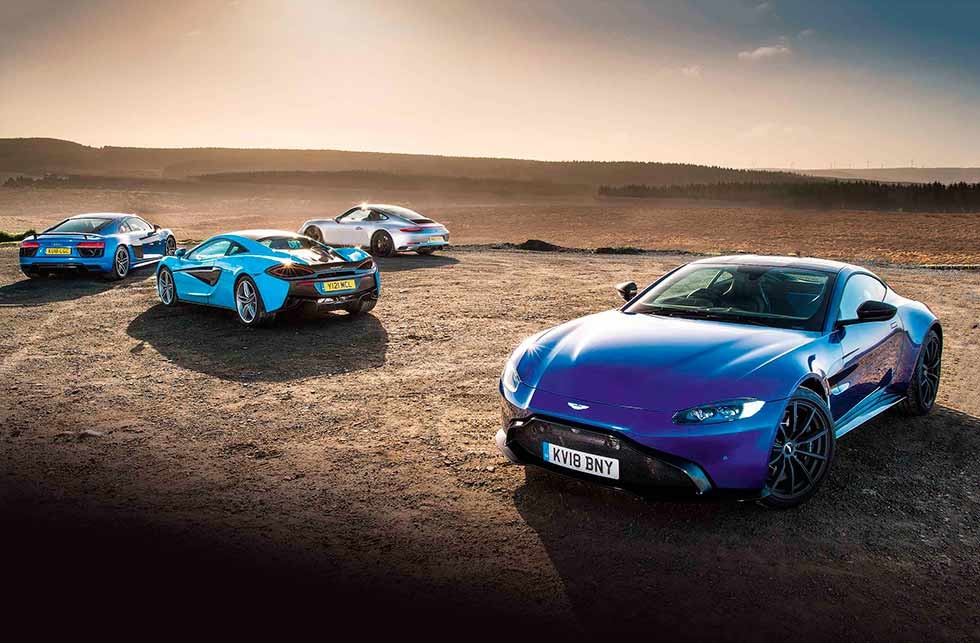
Great Expectations… Aston Martin needs the all-new Vantage to succeed, but with a formidable array of rivals in the shape of McLaren’s 540C, Audi’s R8 V10 Plus and Porsche’s 911 GTS, can it deliver?
VANTAGE v 540C v CARRERA GTS v R8
It’s the morning after the night before, and as Aston Martin’s new Vantage stumbles from its Portuguese launch it finds itself in north Wales with three familiar foes. With McLaren on a roll, Audi offering unexpected thrills and Porsche… well, being Porsche and knocking out great 911s, Aston needs to be on top of its game. Time to discover who has the advantage. Words by James Disdale. Photography by Aston Parrott.
Finally, the wait is over: we’re going to get to drive the Aston Martin Vantage. And I mean really drive it. We’ve already had tasters, but neither of those outings gave us the full picture of a machine that Aston claims has the beating of every significant member of the sports coupe firmament. First there was the drive of a pre-production example on a zero-friction frozen lake and snow-covered roads.
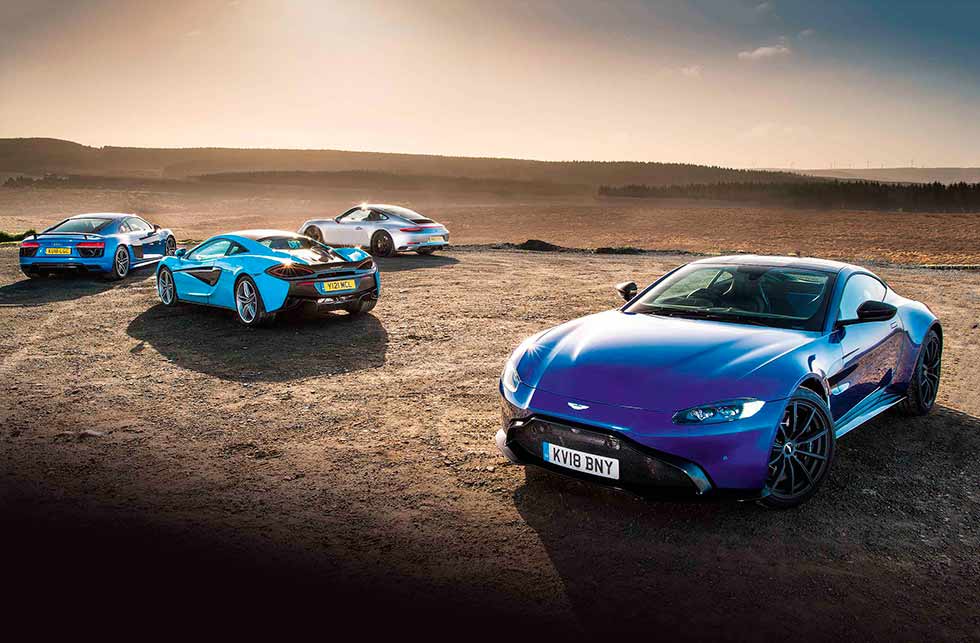
Then came the glamorous launch in Portugal, where we discovered that a 500bhp rear-wheel-drive car is very fast on smooth tarmac and can go spectacularly sideways on a racetrack. But there was still much left to learn about a car that’s likely to be the brand’s biggest seller yet, until the DBX SUV arrives.
And crucial to the future of Aston, too. The previous Vantage was itself the best selling car in the firm’s history and so expectations for the latest version are high to say the least. The company is on an ambitious upward trajectory, with two new models planned every two years from now until 2022, but the strategy only really works if the current cars are bringing in the readies. It’s no secret that the first model from the reinvented company – the DB11 – hasn’t been a roaring success in the showroom, so the pressure is on for the Vantage. England expects, if you will.
To find out if the Vantage is up to the job, we’ve assembled a trio of rivals that have no doubt given Aston’s engineers more than the odd sleepless night. Each is very different in its execution, but in terms of price, performance and focus the Porsche 911 Carrera 4 GTS, Audi R8 V10 Plus and McLaren 540C are vying for exactly the same well-heeled customers. (You may have expected to see an AMG GT here, too, and we had hoped to have one, but sadly Mercedes wasn’t able to supply a car in time for our test, so the Aston will have to square up to the AMG at a later date.)
We’re off to north Wales, and the Vantage strides into battle with a confident swagger, not least in terms of looks. Obviously styling is subjective, but from some angles (profile and rear three-quarters) the complexly surfaced Aston is a real head-turner, and every time we stop it easily draws attention away from the usually magnetic McLaren and Audi (the poor Porsche simply blends into the background in this company). It’s not quite as arresting as its perfectly proportioned predecessor – that bulbous, hammerhead nose with its small headlamps just doesn’t look quite right – but there’s some serious star quality here.
Under the skin it shares parts of its all-aluminium structure with the DB11, but two-thirds of it is new. It also shares the DB11’s eight-speed ZF transaxle gearbox (a traditional torque converter, not a twin-clutch unit like in its rivals) and the DB11 V8’s Mercedes-sourced 4-litre twin-turbo motor, which produces 503bhp, plus 505lb ft of torque from as little as 2000rpm. Yet this is more than a simple front-engined, rear-drive hot-rod, because the Vantage boasts cutting-edge additions such as an electronically managed limited-slip differential, three-way adaptive dampers and active torque vectoring – this car is the most high-tech yet from Gaydon.
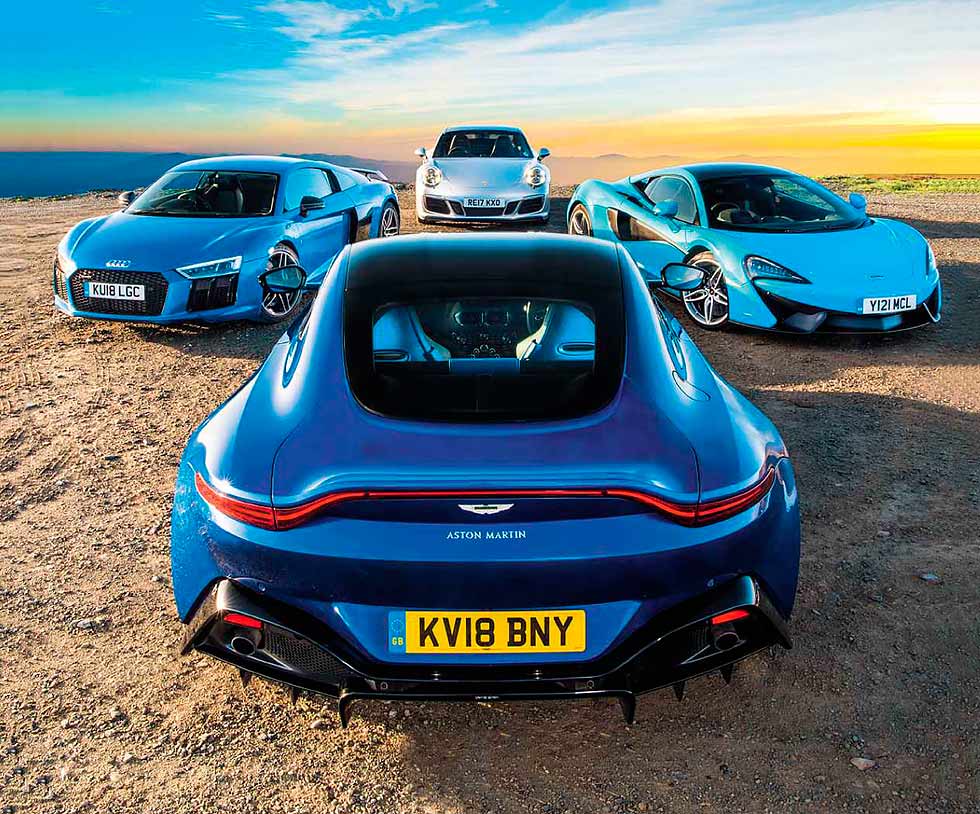
But it still languishes behind the McLaren in this regard. The 540C is the firm’s entry-level model, but it’s dripping with the same sophistication as the straight-rom- the-track Senna. As with all of Woking’s machines, it’s underpinned by a light and strong carbonfibre tub, to which is attached the suspension and the aluminium subframe that cradles the familiar, mid-mounted twin-turbo 3.8-litre V8, here tuned to give 533bhp, with 398lb ft from a high 3500pm. At £127,890 it’s around £7000 more than the Aston, but in this rarefied buying environment such differences are easily brushed aside.
That’s a good thing for Audi, because at £141,200 the R8 V10 Plus is hardly what you’d call a snip. There is a non-Plus version with 533bhp for £126,200, but if Aston is to dominate this sector it will need to see off Audi’s 602bhp flagship. As with the Vantage, aluminium is used extensively in the R8’s construction, while like the McLaren, the engine is mounted in the middle. And what an engine. The naturally aspirated 5.2-litre V10 spins to 8500rpm and delivers a soundtrack that’s arguably worth the price of entry alone. It’s mated to a seven-speed dual-clutch auto that sends drive to all four wheels.
The Porsche is all-wheel drive, too – we reckon its clever electronic set-up delivers all the thrills of the rear-drive 911, but with a welcome dollop of all-weather security. Plus Porsche sells as many Carrera 4s as it does rear-drive versions. And we’ve opted for the GTS spec because Aston did exactly the same when benchmarking the new Vantage.
An engine hanging out over the rear axle puts the 911 at ideological loggerheads with its three challengers here, but it’s a layout that Porsche has refined to near-perfection over more than half a century. Same goes for the flat-six, which is now downsized and turbocharged, the 3-litre unit producing 444bhp and 406lb ft. That’s the weakest showing here, but the Porsche counters with the lowest basic price of £100,781 – although our test car registers an Aston-matching £120,000 when you factor in a raft of options that extends to the PDK transmission, carbon-ceramic brakes (standard on the R8 and 540C) and four-wheel steer.
The 911 has another trump card to play, because before heading for the hills we put each of our contenders on the scales, and despite its four-wheel-drive, four-seat (oh OK, two-plus-two) layout, the Porsche weighs in at 1536kg, which is only 71kg more than the carbon-rich McLaren. By contrast, the big-engined Audi records a figure of 1671kg. The Aston?
An extremely portly and very disappointing 1739kg – there’s clearly some particularly heavy aluminium making its way to the Midlands.
With this figure preying heavily on my mind, I swing open the Aston’s door, which arcs subtly upwards, and lower myself into the cabin. You sit satisfyingly low, cocooned comfortably between the tall transmission tunnel on one side and the high window-line on the other. The interior is arguably less successful than the exterior, with its scattergun approach to the placement of minor switchgear and the slightly jarring confluence of shapes and shut-lines.
There are also some question marks over the quality, with our car suffering from some flimsy-feeling door pockets and windows that don’t always drop as you open the door, causing the glass to strike the frame. Oh, and then there’s that square steering wheel – it wasn’t a good idea in the Austin Allegro and the passing of four-and-a-half decades hasn’t made the concept any more sensible. Visibility is also an issue, the high scuttle and low roof creating a letterbox view forward, while the combination of stout A-pillars and large door mirrors obscures roundabouts and the apex to right-hand corners. Over-the-shoulder vision is terrible, too, with cars as big as a BMW 5-series disappearing behind the C-pillar. The Aston’s rivals feel panoramic by comparison.
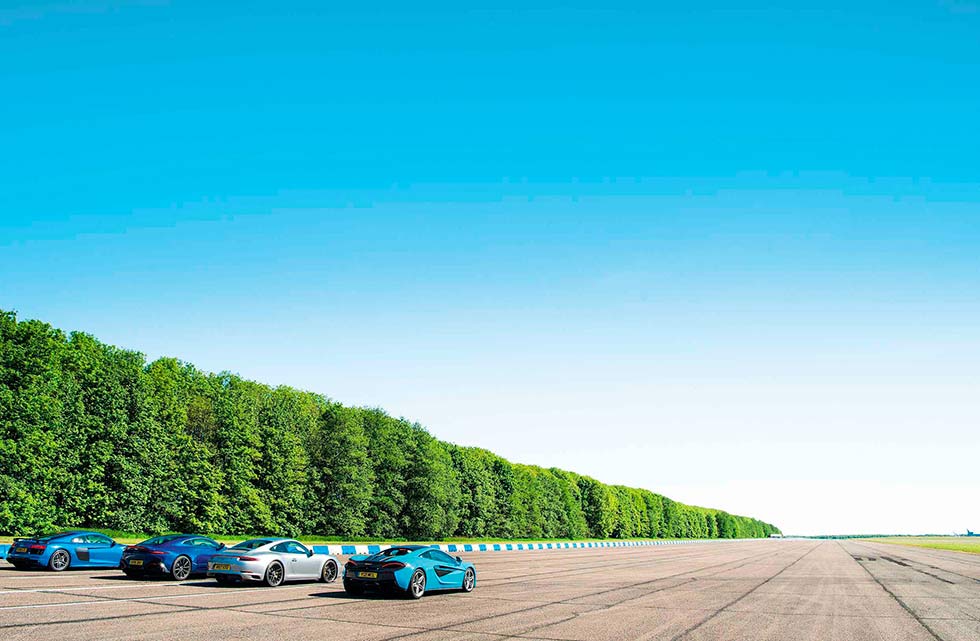
It’s fairly spacious, though, while that hatchback rear gives it a usability USP that rivals the 911’s part-time rear seats. There’s enough room for a set of golf clubs (if you must), but crucially for us the decently shaped boot swallows photographer Aston Parrott’s gear without complaint. Try the same in the McLaren or Audi and the inevitable overspill from the cramped storage in the nose covers the passenger seat and fills the footwell.
Thumb the translucent starter button and the ‘hot-V’ 4-litre flares into noisy life before settling to a surprisingly subdued idle. Aston’s engineers have worked hard on the unit’s mapping, induction and exhaust to give it a character all its own – there’s none of the AMG original’s burble and bombast here. Even when worked hard there’s little to suggest that this is the same engine that’s such an aural riot in a C63.
Still, it’s an effective performer, that rippling torque figure helping offset the high kerb weight and working in combination with the reasonably slick eight-speed slusher to propel the Vantage forward with effortless aplomb. The steering is good, too, serving up decent weighting and a rack that rivals the McLaren for wrist-flick quickness – both the Germans have slower and more deliberate responses to steering inputs.
The Aston’s easy-going character is enhanced by its damping, and on rolling but well-surfaced roads the car rides with a deftness that’s unexpected – only the supple but noisily suspended McLaren comes close. Smaller imperfections and broken tarmac are less adeptly dealt with, the Vantage fidgeting around in a similar manner to the 911. The prize for the best refinement and comfort goes to the R8, which on the monotonous motorway schlep north is no more demanding or tiring to drive than an A3.
Before long we’ve peeled off onto the A5 and it’s time to finally uncork the Aston. I’d cruised up here with the engine and dampers in Sport (the base setting – there’s no Comfort here), but prodding the wheel-mounted buttons unleashes Sport+ and Track modes. I try the former first and there’s a small improvement in throttle response but a greater enhancement in the soundtrack, with valves in the exhaust opening to deliver far more snap, crackle and pop. It’s still not as vocal as the sonorous Audi, but the baritone bark from the small-diameter twin pipes is pleasing enough. Toggling to Track ramps up the volume another notch and adds a distant salvo of gunfire on the overrun as well as a rifle-crack report with each upshift. Subtle it ain’t. The Vantage is quick, though, that generous wedge of midrange twist firing it down the road with a real sense of urgency and allowing you to pick off dawdlers at will. That said, it can’t shake the 911 from its tail, the Porsche matching the Aston move for move.
There’s no denying that the shift to turbocharging for the 991.2 Carreras has robbed their engines of some character. There’s the same hollow metallic howl when really pressing on, particularly when the flaps in the GTS’s standard Sports exhaust are opened, but for the rest of the time there’s a less distinct voice, overlaid with the distant whistle, sigh and flutter of the turbos.
The upside of this less musical delivery is an uplift in performance that no naturally aspirated 911 (GT3s and R aside) could ever hope to match. In the past you really had to wring the flat-six’s neck to make progress, now there’s instant and near lag-free thrust from the moment the needle on the large, centrally positioned rev counter climbs past 2000rpm. With ‘just’ 444bhp the Porsche doesn’t feel rabidly fast, but its blend of lower kerb weight and blink-and- you’ll-miss-them PDK gearshifts (it’s by far the best transmission here in terms of speed and smoothness) means it has no problems shadowing the Aston. Punchy and effective though the Vantage and 911 are, they both have to play second fiddle to the mid-engined competition in the straight-line stakes.
It doesn’t matter how many miles you’ve driven in an R8, you still savour every millimetre of throttle pedal travel. Yes, the ear-splitting start-up is a bit too ostentatious, but then you haven’t bought the R8 because you want to blend into the background, have you? You can, of course, keep the V10 in its Comfort mode, but you’re only delaying the inevitable, because once the engine’s spinning beyond 4500rpm the exhausts are fully uncorked and the operatic Audi is given its head. Best just pop it in Dynamic and have unfettered access to the full symphonic backdrop, from low-rev growl through to that nape-prickling 8000rpm howl.
Of course, there’s plenty of bite to go with the bark. There’s not the same engorged welt of low-down torque as the turbocharged trio, but the bigchested capacity combined with an S-tronic gearbox that mixes reasonably short gearing with seamless shifts means the Audi has an ability to shrink straights with vicious efficiency.
In detuned, 533bhp guise the McLaren’s V8 feels electronically pegged back – just a little; just enough to help create some clear performance air between it and the otherwise mechanically identical 570, but despite this it’s still an explosive performer. Like its more powerful brother, the 540 drags its heels at low revs, and it’s only beyond 3000rpm that the McLaren suddenly wakes up, the twin compressors coming on song in a sudden, adrenaline-fuelled rush for the red line.
This old-school turbo delivery is not sophisticated, but it’s hugely addictive and you find yourself deliberately dropping off boost just so you can repeat the whole head-spinning process.
Keep the engine on the boil, though, making plenty of use of the gorgeous carbonfibre paddle-shifters, and the 540 will cover ground at such a rate that you might need to lie down at journey’s end, fearing for your licence. It’s just a shame the flat-plane-crank V8 sounds so ordinary, chuntering away at idle and turning to a deep blare that’s borderline unpleasant when extended.
When we arrive at our overnight stop in Betws-y-Coed I make a beeline for bed with my head full of more questions than answers, because despite such similar briefs these four cars are very disparate in the way they go about their business. Still, tomorrow is another day, and experience tells me that the tortuously testing roads we have in mind will help clarify the situation.
We rise early the next day, but despite the bleary-eyed alarm call I’m keen to get back in the Aston and really get under its skin. Chief engineer Matt Becker and his team spent plenty of time developing the car on these very roads, so this is arguably a home advantage for the, erm, Vantage. As we head out of Ffestiniog, the Aston feels big (at 1942mm it’s a few millimetres wider than the Audi and McLaren, but some 90mm more than the 911). It only just fits between the stone wall and centre white lines, and the feeling of claustrophobia isn’t helped by the poor visibility. Still, as the road opens out, the Vantage gets into its stride and I can start to exploit its pace and natural balance.
I’ve switched the dampers and engine to Sport+, and it feels good, that quick steering helping place the long nose accurately, while the combination of relatively soft rear axle and e-diff serves up impressively strong traction, in the dry at least. There’s decent feedback through the wheel, too, and a feeling that the car is pivoting about its centre, allowing you to scythe through faster corners with minimal effort.
Most surprising is how docile the Aston is to throttle inputs. With that muscular V8 up front I was expecting to deal with armfuls of opposite lock when the traction control is disengaged, but instead it feels planted, any throttle application merely helping tighten your line.
Of course, the Vantage can be made to misbehave, but you have to upset the car’s balance on turn-in with a sudden steering input or a stab of the brakes. Even then, certainly within the confines of the road, the clever diff wants to get the car as straight as possible, as soon as possible. Yet as the pace increases, the Aston’s demeanour changes, the undulating road and increased cornering loads causing its composure to unravel. Push really hard and even in its Track setting it’s clear the suspension is struggling to keep the masses in check. Accelerate on rippled surfaces and the Aston’s rear axle gets itself tied in knots, thumping and thudding as it tries to juggle the demands of both going forward and containing vertical movements.
A similar situation happens mid-corner, the chassis writhing this way and that as the hefty kerb weight finally gets the better of the damping – bumps knock the car offline, while compressions are met with the pfssssst scrape of front splitter skimming tarmac. It’s great at eight-tenths, but attempt to keep pace with the other three and the heavyweight Aston gets itself into something of a muddle.
In many ways it’s the opposite of the Audi, which feels just a little ordinary when you’re stroking it along. The steering is light and surprisingly slow, plus there’s very little feedback, making it hard to judge how much speed you can carry into corners. You also feel that mass hanging in the middle of the car, which combined with the lack of turn-in bite conspires to make the R8 feel a little cumbersome – get on the throttle as early as you would in the others and the Audi wants to run wide.
Maybe if I flick on Dynamic mode and push on a little? Ah, that’s better. The quattro drivetrain feels more rear-biased now, allowing you to use the poke of that glorious engine to trim your line. There’s more heft to the steering (although not much in the way of added feel), while the dampers tense up nicely, keeping body movements tightly controlled but still allowing the car to ride the bumps with real serenity.
You can really kick on now, devouring these rollercoaster roads at such a rate that the bucking Aston has to drop back. I can’t shake that pesky McLaren, though, and after a quick stop and a car swap it’s not hard to see why.
It always feels special to swing open the dihedral door of a McLaren, step over the wide sill and lower yourself into that race car-inspired driving position. Like Mercedes has done with all its saloons below the S-class, McLaren has managed to distil the essence of its flagship into everything it does.
All the cars here are special, but the 540C feels especially so. There’s that recumbent seating layout, the goldfish-bowl view forward. Glance in the door mirrors and you glimpse those gaping intake ducts, while coming to a stop after a hard run has you gazing into the rearview mirror at the heat haze dancing in the air. It feels like a proper supercar. It drives like one as well. For starters there’s the steering – hydraulically assisted, remember – which gently bucks and writhes in your hands as it gives you an unstinting commentary of what’s rolling under the front wheels, goading you into confidently carrying ever more speed into the corners, where the 540 takes on a fast and flat attitude.
It really is sublimely balanced and beautifully poised, and even in their Comfort settings the dampers shrug off everything these roads can throw at them. Ramping up to Sport does nothing to diminish the 540’s ability to breathe with the tarmac; it simply adds a smidgen of extra tautness for ultimate control.
As with most McLarens there’s no limited-slip differential. Instead the 540 relies on its talent to be quickly rotated at the apex with the combination of heavy braking, keen steering that’s connected to front tyres with superglue tendencies, and a rear end that moves around gently, always alert to a change of direction.
It’s a beguiling experience and encourages you to drive more neatly than in the other three, picking off corners and straights at an alarming rate. If only the engine could match the rest of the dynamic package by adding a little more aural excitement. Perhaps if it had the Audi’s V10. Now there’s a thought.
And what about the 911 991.2? Well, I’ve saved it until last because it is the car that Aston targeted in its development of the Vantage. The mid-engined missiles might be proving a step too far for the Aston, but the more useable Porsche should be fair game.
Yes, the 911’s familiarity arguably breeds contempt, and sitting in front of that familiar five-dial instrument cluster it feels the most mainstream. But up here in the hills the GTS turns on the magic and you’re suddenly marvelling at its incredible reserves of ability.
Its compact dimensions make it feel easily the most wieldy, and while it feels heavier than the Vantage at lower speeds (the result of hefty steering and the subtle sense of that engine hanging over the rear axle), as the speeds rise, the Porsche’s mass simply melts away.
No, its steering isn’t as fast as the McLaren’s or as detailed in its feedback, but it gives you everything you need to know, plus its rate of response is beautifully natural. As are the brakes, while the front axle’s ability to lock onto your chosen line is uncanny. The four-wheel steering helps here, but I’ve driven enough traditional 991s to know that this other-worldly turn-in is a feature throughout the line-up. The grip and traction are also jaw-droppingly good, and so approachable is the handling that despite its power deficit, the GTS can stay right on the heels of the McLaren.
Snap the throttle closed mid-corner and that engine acts like a pendulum, swinging the tail around. But it’s never nerve-wracking, it simply helps tighten the Porsche’s line for a straighter exit or, if you’re feeling frisky, with a sniff of power oversteer, the clever four-wheel drive second-guessing your wishes and shuffling torque rearwards.
While the Audi, and arguably the McLaren, need to be driven with this sort of intent to unlock their potential, the 911 991.2 rewards at any speed. And the more you goad it, the better it gets.
It’s been a fascinating and thrilling couple of days and an order is starting to crystallise in my mind, but before we reach any conclusion there’s the small matter of a trip to Bruntingthorpe Proving Ground to see which one of our quartet has the straight-line performance bragging rights.
Rating and photos
‘All the cars here are special, but especially so the 540C. It feels like a proper supercar’
‘Once beyond 4500rpm the exhausts are fully uncorked and the operatic Audi is given its head’
‘The Vantage is quick, firing down the road with a real sense of urgency’
Above: twin-turbo V8’s 505lb ft of torque helps offset the Vantage’s hefty 1739kg kerb weight, and puts the car in a new league performance – wise.
‘An engine out over the rear axle puts the Porsche at ideological loggerheads with its challengers’
‘The Vantage strides into battle with a confident swagger, not least in terms of looks’
Drive-My ratings
Aston Martin Vantage 4.6
Porsche 911 Carrera 4 GTS 991.2 4.9
Audi R8 V10 Plus 4.8
McLaren 540C 4.7
THE DATA
The long runway stretches ahead, the shimmering heat haze distorting its far end. The Audi is up first to charge towards it, and thanks to its four-wheel drive and launch control it should be a doddle to get off the line.
With the ESP and transmission in their Sport settings, I floor the throttle and wait for the revs to settle at about 4500rpm before slipping my left foot off the brake.
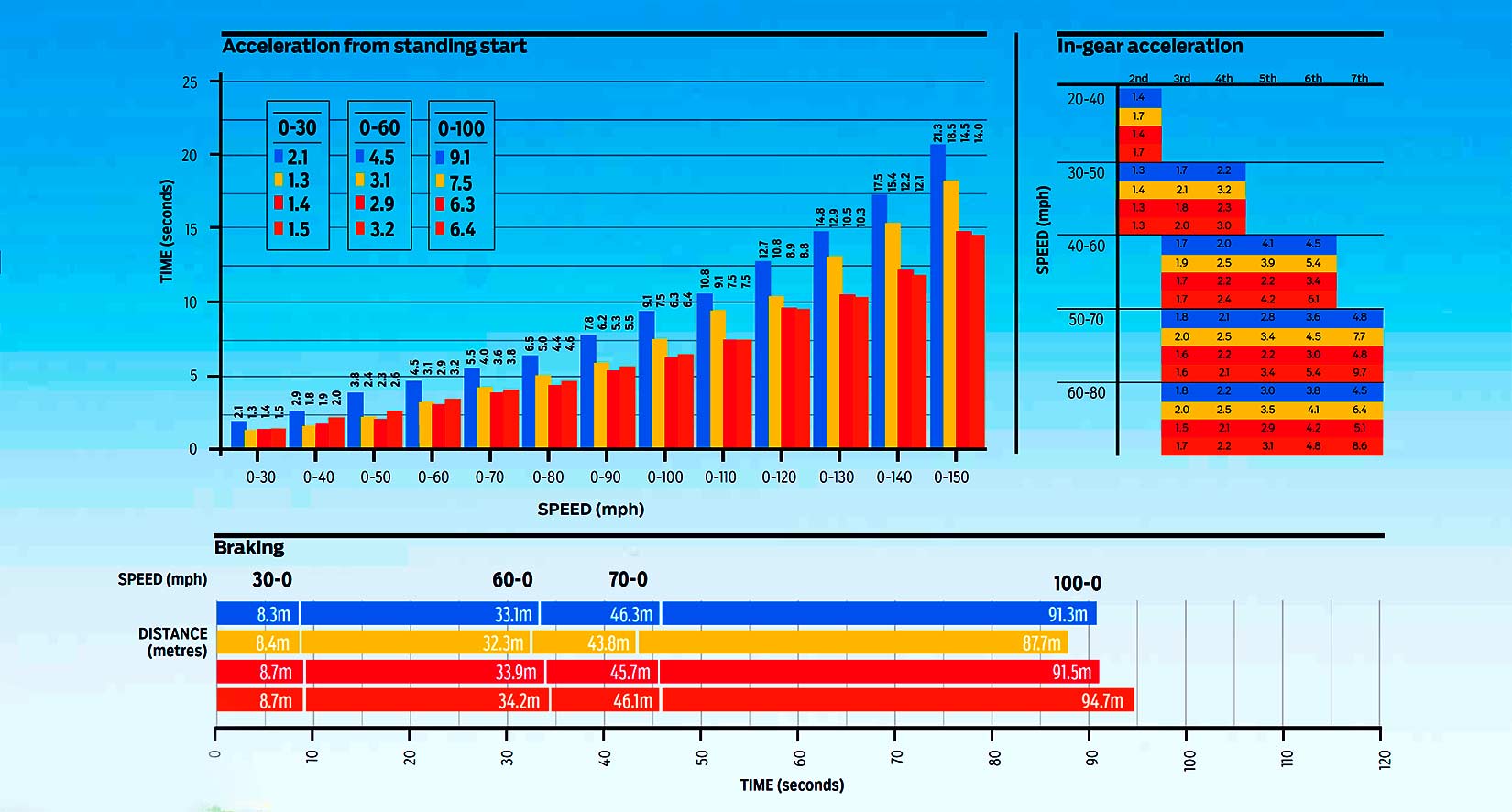
There’s a momentary pause and then the R8 rockets off the line, screaming unrelenting and rock-steady to 150mph, at which point I lift my right foot and glance at the VBOX. It shows the 0-60mph dash was ticked off in just 2.9sec. Wow!
Equally easy to fire off the line is the 911, which zaps to 60mph in 3.1sec. Stunning four-wheel-drive traction helps it nearly match the R8, but power tells eventually, and by 150mph the Porsche is four seconds in arrears.
Next up is the rear-drive McLaren, which takes a little more effort to extract the maximum from. The first couple of runs are around 3.6sec to 60mph, but by the time we do the third the tyres are warm and the 540 clocks a 3.2sec time. Finally, we get to the Aston. Its launch control requires the stability and traction aids to be disengaged, but a couple of slow, tyre-smoking runs through the first four gears suggests a different approach is needed. With ESP in its Sport mode we get better traction, but there’s still power being sapped away by the computers, and the result is a best time of 4.5sec (Aston claims 3.6sec to 62mph).
Perhaps a more realistic picture of the Vantage’s performance can be gleaned from the in-gear acceleration, where it trades blows with the McLaren over most increments. Either way, there’s no hiding the Aston’s instability at speed, the car moving around unnervingly from 120mph – its three rivals are far more confidence-inspiring at big numbers.
All four cars serve up eye-popping stopping power, but it’s the 911 that comes to a halt in the shortest distance in all but one of our tests (see table). However, the brake pedal goes spongy at full pressure, the firmness only coming back at the end of a run when the emergency systems relinquish their control. Best for feel and consistent pressure are the McLaren and Aston – the latter putting on an impressive show given its considerable kerb weight and the fact it is the only car using standard cast-iron discs.
| Car |
Aston Martin Vantage |
Porsche 911 Carrera 4 GTS |
Audi R8 V10 Plus
|
McLaren 540C |
| Engine type | V8, 3982cc, twin-turbo | Flat-six, 2981cc, twin-turbo | V10, 5204cc | V8, 3799cc, twin-turbo |
|
Max Power DIN |
503bhp @ 6000rpm | 444bhp @ 6500rpm | 602bhp @ 8250rpm | 533bhp @ 7500rpm |
| Max Torque DIN | 505lb ft @ 2000-5000rpm | 406lb ft @ 2150-5000rpm | 413lb ft @ 6500rpm | 398lb ft @ 3500-6500rpm |
| Transmission type |
Eight-speed auto, rear-wheel drive, limitedslip differential, torque vectoring |
Seven-speed dual-clutch (option), fourwheel drive, limited-slip diff, torque vectoring |
Seven-speed dual-clutch, four-wheel drive, limited-slip differential, torque vectoring |
Seven-speed dual-clutch, rear-wheel drive, torque vectoring by braking |
| Tyres |
285 ZR20 |
275 ZR20 | 265 ZR19 | 295 ZR21 |
| Length / Wheelbase | 4465/2704mm | 4528/2450mm | 4426/2650mm | 4530/2670mm |
| Height / Width | 1273/1942mm | 1284/1852mm | 1240/1940mm | 1202/1930mm |
| Corner weights | 432/414/444/449kg (RF/LF/RR/LR) | 306/283/468/479kg (RF/LF/RR/LR) | 355/346/485/485kg (RF/LF/RR/LR) | 322/284/445/414kg (RF/LF/RR/LR) |
| Weight | 1739kg as tested (1530kg ‘dry’ claimed) | 1536kg as tested (1515kg claimed) | 1671kg as tested (1580kg claimed) | 1465kg as tested (1311kg ‘dry’ claimed) |
| Power-to-weight |
294bhp/ton as tested (334 ‘dry’ claimed) |
294bhp/ton as tested (298bhp/ton claimed) |
366bhp/ton as tested (387bhp/ton claimed) | 370bhp/ton as tested (413 ‘dry’ claimed) |
| 0-60mph | 4.5sec as tested (3.6sec to 62mph claimed) | 3.1sec as tested (3.6sec to 62mph claimed) | 2.9sec as tested (3.2sec to 62mph claimed) | 3.2sec as tested (3.5sec to 62mph claimed) |
|
Top speed |
195mph (claimed) | 191mph (claimed) | 205mph (claimed) | 199mph (claimed) |
| Test mpg | 24.4 | 27.6 | 19.1 | 20.0 |
| Basic price UK 2018 | £120,900 |
£100,781 |
£141,200 | £127,890 |
| PCP monthly price | – |
£428 (36 months, £12,100 deposit, 10,000 miles per annum limit) |
£549 (48 months, £11,069 deposit, 10,000 miles per annum limit) |
|
| Club |
– |
{module PORSCHE 991} |
|
‘The Audi screams unrelenting and rock-steady to 150mph’
THE VERDICT
Think what you will of the Vantage’s looks, there’s no denying it attracts attention, while its performance is in another league to the old version, V8 and V12-engined. It also feels far more sophisticated than before, plus it’s genuinely engaging and entertaining to drive. Up to a point. What happens when you push the car harder ultimately undermines its bid for victory. Because, where our other three contenders up their game the more you ask of them, the Aston gets into a muddle as the chassis clearly struggles to keep a handle on the car’s mass (why oh why is it so heavy?).
Further demerits are the poor visibility, an occasionally truculent gearbox and some niggling doubts over build quality. You can sense there’s a really good car lurking within the new Vantage, but it feels as if further development is required before it will show itself – much as is happening with each new DB11 variant. Finishing narrowly ahead of the Aston is the Audi. Much of its appeal lies in that magnificent engine, which delivers the sort of music and motive force no other car here can match – this unit will surely go down as one of the all-time internal-combustion greats. Yet there’s more to the R8 than that. It is a car shot through with so many streaks of high-adrenaline brilliance, and in direct contrast to the Vantage it gets better the harder you go, delivering staggering cross-country pace and composure and, steering aside, a drive that’s as involving as it is intoxicating. The fact the Audi can feel a little ordinary when taking it steady will be either a blessing or a curse depending on your point of view.
‘Ordinary’ is not a word you could use to describe the McLaren. It gets the heart racing before you’ve so much as touched a door handle. It looks like a genuine supercar, a feeling that’s merely intensified as you slide yourself into that driving position. It drives beautifully, too. By paring back on some of McLaren’s more high-tech systems, the 540 (like the 570) is more touchy-feely from behind the wheel and can be enjoyed at more real-world speeds. It’s just a shame it’s undermined by an engine that, while brutally effective, is short on character and sophisticated delivery. It’s a small thing maybe, but it’s enough to let the Porsche in to steal victory.
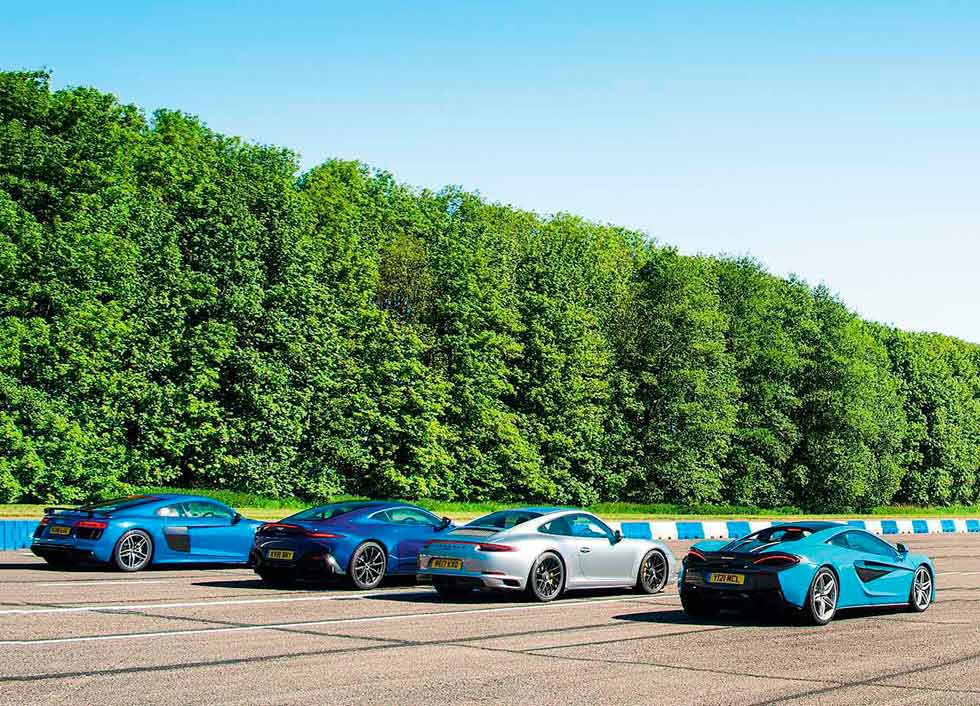
In GTS 4 guise the 911 is arguably the most complete sports coupe you can buy. Practicality and usability are givens, as is the muscle of the blown flat-six and the ability of the chassis to offer up dexterity and delicacy in one uniquely delivered package. Here is a car that feels just as special mooching as it does monstering the most testing roads you can throw it at. As for Aston Martin, it clearly has some work to do. The Vantage’s inconsistent abilities in different environments, combined with how it requires the driver to adopt a prescribed style to realise its undeniable potential, are factors that need attention sooner rather than later.





